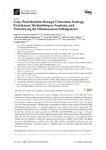Mostrar o rexistro simple do ítem
Gene Prioritization through Consensus Strategy, Enrichment Methodologies Analysis, and Networking for Osteosarcoma Pathogenesis
| dc.contributor.author | Cabrera-Andrade, Alejandro | |
| dc.contributor.author | López-Cortés, Andrés | |
| dc.contributor.author | Jaramillo-Koupermann, Gabriela | |
| dc.contributor.author | Paz-y-Miño, César | |
| dc.contributor.author | Pérez-Castillo, Yunierkis | |
| dc.contributor.author | Munteanu, Cristian-Robert | |
| dc.contributor.author | González-Díaz, Humberto | |
| dc.contributor.author | Pazos, A. | |
| dc.contributor.author | Tejera, Eduardo | |
| dc.date.accessioned | 2020-03-04T15:20:17Z | |
| dc.date.available | 2020-03-04T15:20:17Z | |
| dc.date.issued | 2020-02-05 | |
| dc.identifier.citation | Cabrera-Andrade A, López-Cortés A, Jaramillo-Koupermann G, Paz-y-Miño C, Pérez-Castillo Y, Munteanu CR, et al. Gene Prioritization through Consensus Strategy, Enrichment Methodologies Analysis, and Networking for Osteosarcoma Pathogenesis. Int. J. Mol. Sci. 2020; 21:1053. | es_ES |
| dc.identifier.issn | 1422-0067 | |
| dc.identifier.issn | 1661-6596 | |
| dc.identifier.issn | 1424-6783 | |
| dc.identifier.uri | http://hdl.handle.net/2183/25108 | |
| dc.description.abstract | [Abstract] Osteosarcoma is the most common subtype of primary bone cancer, affecting mostly adolescents. In recent years, several studies have focused on elucidating the molecular mechanisms of this sarcoma; however, its molecular etiology has still not been determined with precision. Therefore, we applied a consensus strategy with the use of several bioinformatics tools to prioritize genes involved in its pathogenesis. Subsequently, we assessed the physical interactions of the previously selected genes and applied a communality analysis to this protein–protein interaction network. The consensus strategy prioritized a total list of 553 genes. Our enrichment analysis validates several studies that describe the signaling pathways PI3K/AKT and MAPK/ERK as pathogenic. The gene ontology described TP53 as a principal signal transducer that chiefly mediates processes associated with cell cycle and DNA damage response It is interesting to note that the communality analysis clusters several members involved in metastasis events, such as MMP2 and MMP9, and genes associated with DNA repair complexes, like ATM, ATR, CHEK1, and RAD51. In this study, we have identified well-known pathogenic genes for osteosarcoma and prioritized genes that need to be further explored. | es_ES |
| dc.description.sponsorship | Instituto Carlos III; PI17/01826 | es_ES |
| dc.description.sponsorship | Xunta de Galicia; ED431C 2018/49 | es_ES |
| dc.description.sponsorship | Xunta de Galicia; ED431G/01 | es_ES |
| dc.language.iso | eng | es_ES |
| dc.publisher | M D P I AG | es_ES |
| dc.relation.uri | https://doi.org/10.3390/ijms21031053 | es_ES |
| dc.rights | Atribución 3.0 España | es_ES |
| dc.rights.uri | http://creativecommons.org/licenses/by/3.0/es/ | * |
| dc.subject | Gene prioritization | es_ES |
| dc.subject | Osteosarcoma | es_ES |
| dc.subject | Communality analysis | es_ES |
| dc.subject | Pathogenesis | es_ES |
| dc.subject | Early recognition | es_ES |
| dc.title | Gene Prioritization through Consensus Strategy, Enrichment Methodologies Analysis, and Networking for Osteosarcoma Pathogenesis | es_ES |
| dc.type | info:eu-repo/semantics/article | es_ES |
| dc.rights.access | info:eu-repo/semantics/openAccess | es_ES |
| UDC.journalTitle | International Journal of Molecular Sciences | es_ES |
| UDC.volume | 21 | es_ES |
| UDC.issue | 3 | es_ES |
| UDC.startPage | 1053 | es_ES |
| dc.identifier.doi | 10.3390/ijms21031053 |
Ficheiros no ítem
Este ítem aparece na(s) seguinte(s) colección(s)
-
INIBIC-RNASA-IMEDIR - Artigos [47]
-
GI-RNASA - Artigos [195]






